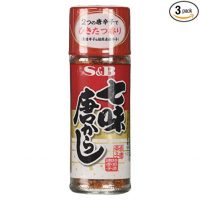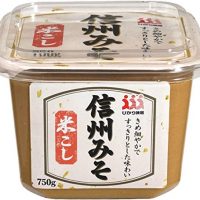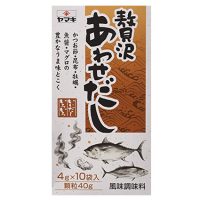Japanese Pork Rice Bowl (Butadon)
This post contains affiliate links.
This Japanese Pork Rice Bowl is quick and easy to make, packed with umami, and extremely comforting! Pork belly is simmered with onions and aromatics in a slightly sweet and mouthwatering sauce.
Japanese Pork Rice Bowl. Or known as Butadon in Japan.
My new favorite easy weeknight dinner! I’ve made it so many times this past month that I fear my family might disown me because of the number of times I’ve answered their question, “What are you eating for dinner tonight?” with an the excited and loud exclamation, “BUTADON!!”. 😂
But can you blame me for making it so often? I mean it’s crazy delicious and stupid easy to cook! Actually it kind of cooks on its own because the mouthwatering thin pork belly strips simmer in the OOBER delicious sauce and dashi stock combination for a couple of minutes while you go answer a few emails, paint your nails, or make a grocery shopping list. AKA do what you need to do before dinnertime. Then you come back and uncover the wok, scoop up some of the pork over a bowl of steamed rice, grab a spoon, and go straight to heaven with the first bite!
Guys, trust me. This is one recipe that you’ll want to bookmark because I guarantee you’ll be making it over and over again! Why?
- It tastes good.
- It looks good.
- It’s a yummy Japanese home-style cooked meal that can be on your table in just 40 minutes.
- …and simply put, it’s pork belly-li-cious good! 😋
It’s Butadon time!
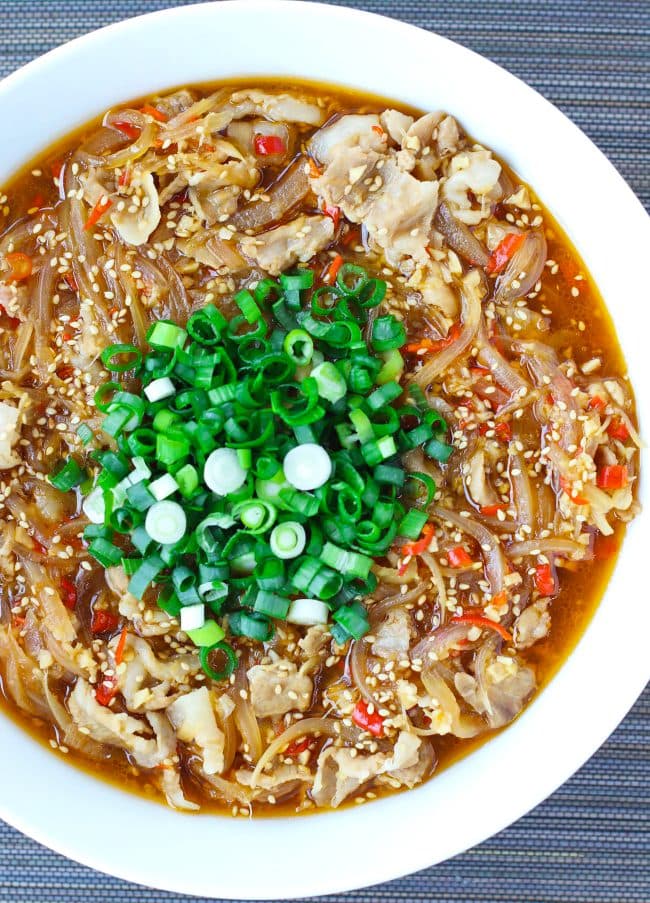
WHAT IS BUTADON?
Butadon literally translates to pork bowl, and it’s a popular dish in Japan that’s made with pork that is simmered in a delicious, slightly sweet sauce. The sauce is made with with dashi (Japanese fish stock), soy sauce, and mirin (Japanese rice wine) usually. But I like to add white miso paste for an extra punch of umami. I also add sake (Korean or Japanese rice wine) in order to not overpower the dish with the sweet mirin.
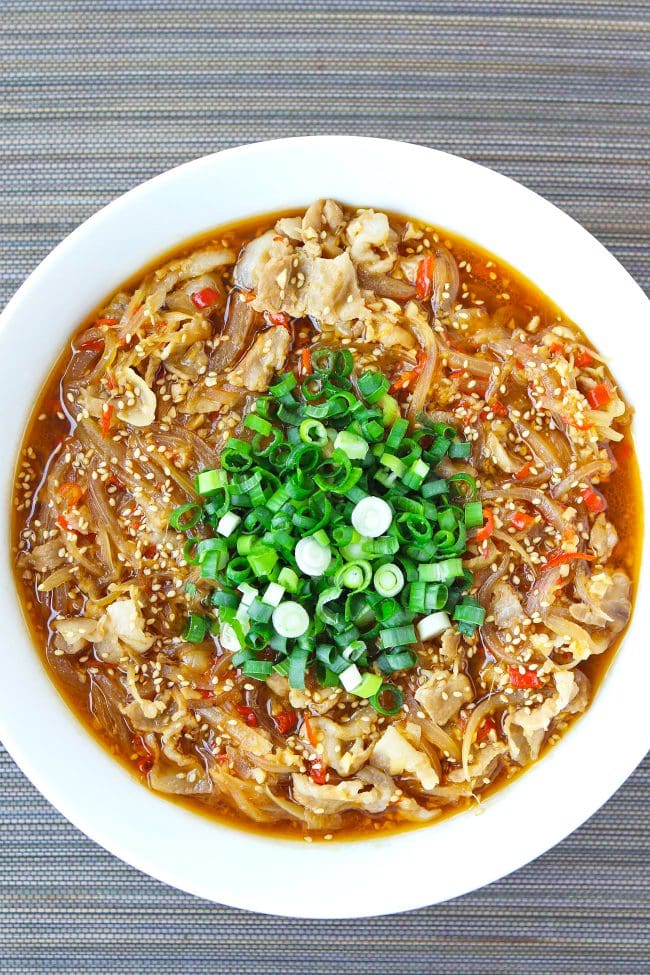
I truly adore this dish because it comes together very quickly, and also because it’s mouthwateringly tasty! Also, there’s very little active cooking involved since the pork simmers and gets cooked to perfection in the delicious sauce on its own. So it’s perfect since it’s an easy dinner for busy weeknights…which lately, has been the norm for me. Guys, this truly is a wonderful and tasty bowl of Japanese comfort food at its best! 💛
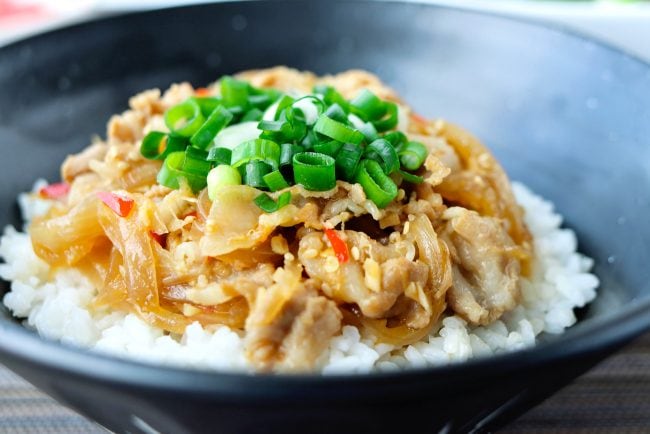
WHAT TYPE OF PORK TO USE?
Since ‘Buta’ means pork and ‘don’ comes from donburi (rice bowl), you really can use any type of pork cut you like. But in my honest and pork-inhaling-and-longtime-loving opinion), this dish tastes best with thinly sliced pork belly.
I basically now am addicted to Japanese pork belly slices (or at my local AEON in Hong Kong, it’s called Japanese Okinawa Pork Rib Slice). Sure, the Okinawa region pork belly might be pricier here (and in the USA) than in Japan. But I am willing to pay a little extra because it’s amazingly good! It braises, simmers, stir-fries so spectacularly that I want to eat it and use it in EVERY pork dish I create henceforth, and also in this Stir-fried Pork Sukiyaki in Black Pepper Sauce dish!
It’s super tender and juicy, if I can describe such a thin slice of pork that way, even after braising or simmering for plenty of minutes in this Butadon dish. Weird right? But not so weird, because it is what is, and it’s incredibly delicious.
So, do purchase some good quality pork belly for this recipe. I promise you’ll be glad you did. 😉
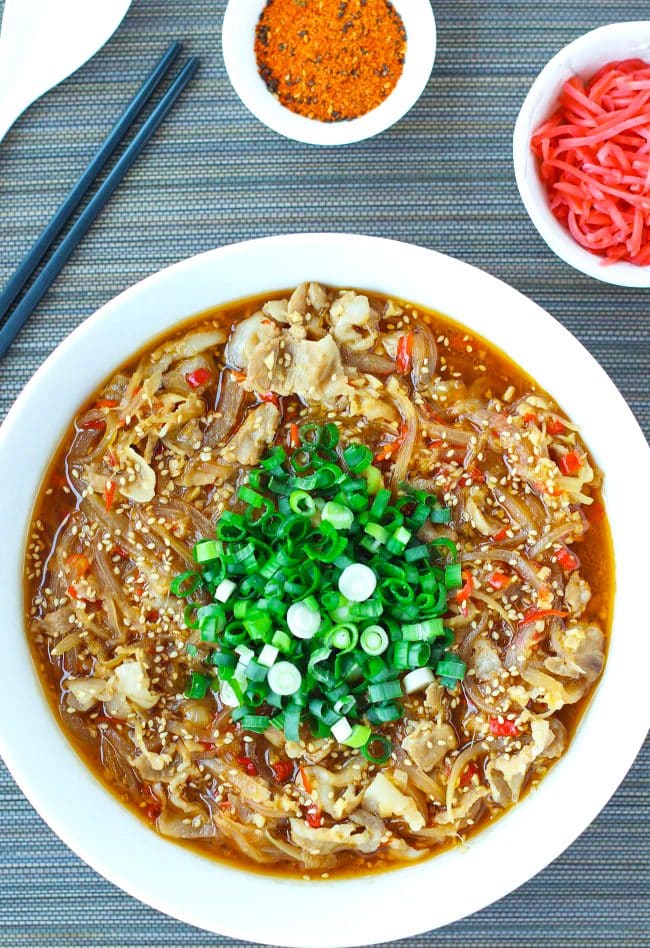
JAPANESE PORK RICE BOWL (BUTADON) INGREDIENTS
To make this quick and easy Butadon, you’ll need some everyday ingredients, as well as some Asian pantry staples.
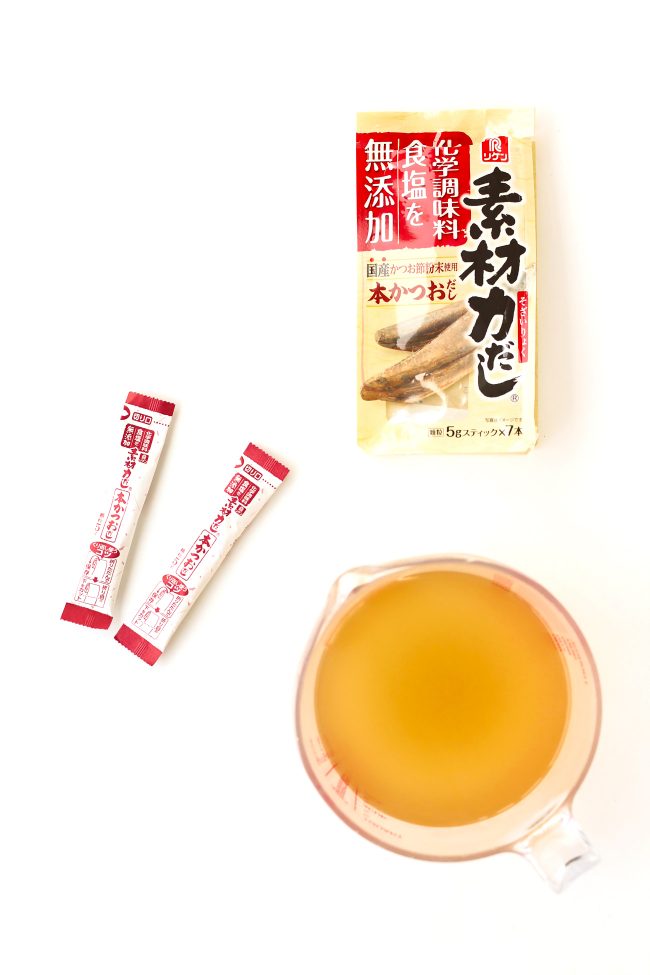
- Pork Belly: I use Japanese Okinawa pork belly wafer-thin and long strips (like bacon, but much more thin) and cut them up into bite-sized strips. You can find thinly sliced pork belly in packages at Asian supermarkets. Or you can buy some regular thick cut of pork belly and thinly slice it at home yourself.
- Yellow Onion: Thinly sliced. Feel free to use white onion if you have that on hand instead.
- Garlic: I love this dish to have a nice garlicky flavor and use ten cloves! But feel free to use less if you like.
- Ginger: Grated please.
- Spring Onion: Chopped small, and for garnish.
- Red Chilies: You won’t typically find red chilies in Butadon in Japan, and this is my addition to make it spicy and delicious! 😍🌶 But feel free to leave the chilies out or deseed them if you want to make this mild. Or just use as much or as little as you like.
- Butadon Sauce: A quick and easy combination of low sodium light soy sauce, mirin (Japanese sweet rice wine), and sake (Korean or Japanese rice wine).
- Dashi stock (Japanese fish stock): Dashi is a stock made from kelp, shitake mushrooms, anchovies (or sardines), and dried bonito flakes. I use sachets of dashi powder and add them to simmering water to make “instant” dashi. You can also use dashi granules that come in small bottles to make the instant fish stock. Look for dashi powder (or granules) in your local Asian grocery store. (Note: I should note that I used more dashi powder in the water than called for because I found that the suggested measurements on the package that I used resulted in a too bland and flavorless dashi. Depending on the brand you use, you may also need to adjust the dashi powder to water ratio to suit your taste.)
- White Miso Paste: A Japanese umami packed paste that is made by fermenting soybeans with rice, as well as some other ingredients. This comes in small cartons and can be found in your local Asian grocery store. Some large supermarkets will also carry cartons of miso paste.
- Brown Sugar: Use more to taste if you like, but since mirin is a sweet rice wine, I didn’t want use too much sugar and risk making the dish too sweet for my taste. But feel free to use a bit extra if needed. 👌
- Kosher Salt: To taste.
- Oils (for cooking): I used a combination of olive oil, sesame oil, and chili oil. But the chili oil is totally optional and you can omit it if you prefer to make this dish mild.
- Toasted White Sesame Seeds: To sprinkle on top of the cooked dish and for more texture!
- Steamed rice: For serving. I love Japanese short grain white rice and always cook it at home, even for fried rice even though most people will opt to use long grain rice for fried rice! Feel free to serve this with any type of rice you usually use at home, including brown rice if you want to be healthy. 😉
- Optional toppings: Pickled red ginger and shichimi togarashi (Japanese assorted red chili powder).

HOW TO MAKE JAPANESE PORK RICE BOWL (BUTADON)
To make this easy and delicious Butadon recipe, start by getting the prep work out of the way.
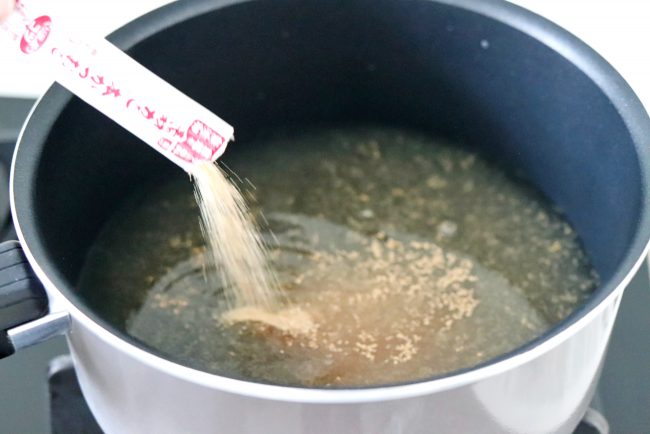
- Prepare all the fresh ingredients: Chop the garlic, red chilies, and spring onion, and grate the ginger. Cut the thinly sliced pork belly into bite-sized strips.
- Make the sauce: In a measuring cup or medium sized bowl, combine the low sodium light soy sauce, mirin, and sake. Stir with a spoon until combined.
- Make the Dashi: Heat the water in a small stockpot or pot over medium-high heat. Once the water starts simmering, pour in the contents of the dashi powder sachets and stir to combine. Simmer for a minute, then switch off the heat and transfer the dashi to a measuring cup and set aside.
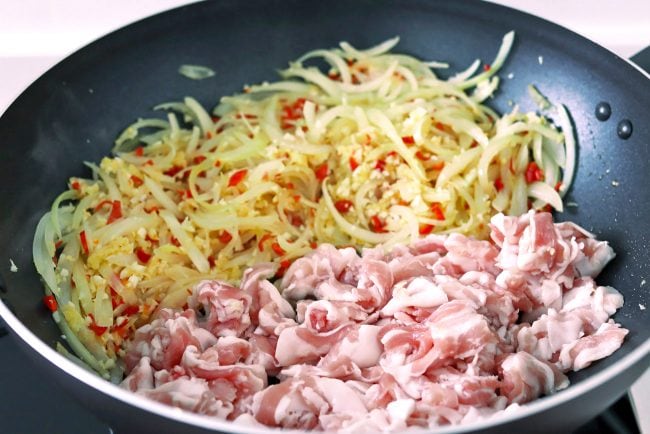
Now that all the prep work is done, making these Japanese Pork Rice Bowls is very simple and straightforward.
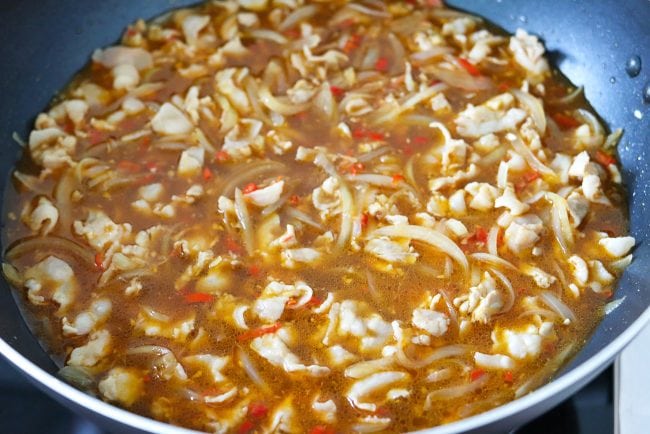
- Heat olive oil, sesame oil, and chili oil in a large wok or stockpot over medium-high heat. Once hot, add the onion and sauté until softened – about 2-3 minutes.
- Add the garlic and ginger, and continue sautéing for 1-2 minutes until fragrant.
- Next, add the chilies and sauté for another minute to combine.
- Then add the pork and stir-fry until no longer pink.
- Pour in the dashi and sauce, and add the white miso paste, brown sugar, and kosher salt to taste. Stir to combine, then lower the heat to medium-low and cover the wok with its lid.
- Simmer for 12-15 minutes, stirring once or twice in between, then uncover the wok and turn the heat back up to medium-high.
- Give everything a good stir and allow the sauce to reduce further for 2-3 minutes while stirring occasionally. Then switch off the heat and transfer to a serving dish.
- To Serve/Garnish: Sprinkle the toasted white sesame seeds and drizzle a little bit of sesame oil on top. Garnish with the chopped spring onion and serve over warm steamed rice, and with pickled red ginger and shichimi togarashi on the side if desired.
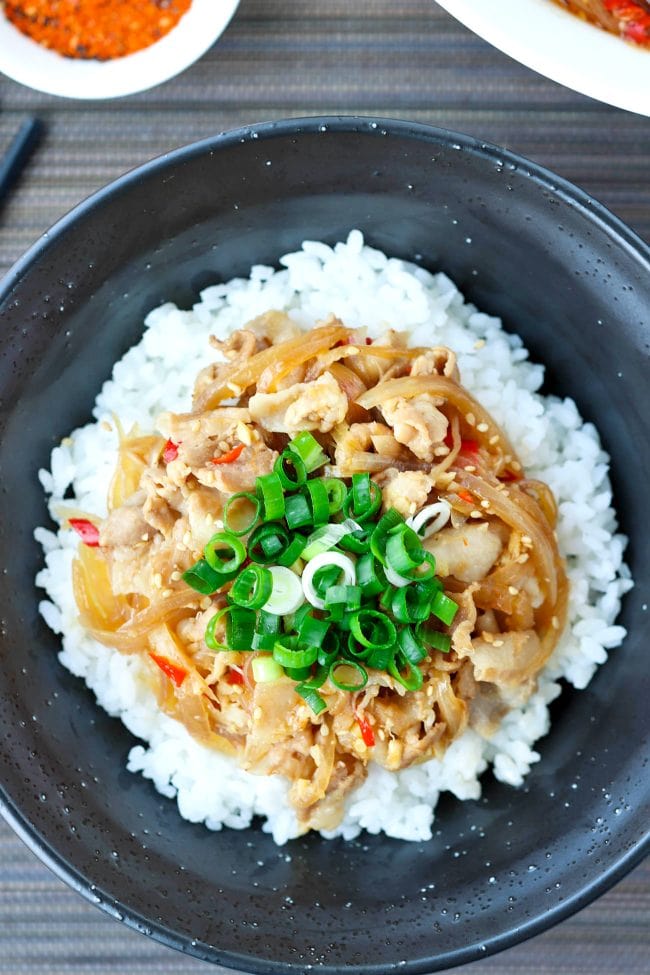
CAN I MAKE THIS GLUTEN-FREE?
Yes, indeed you can! Simply use Tamari or gluten-free soy sauce in place of the low sodium soy sauce. Also, double-check to ensure that the white miso paste, sake, and mirin you are using is GF certified.
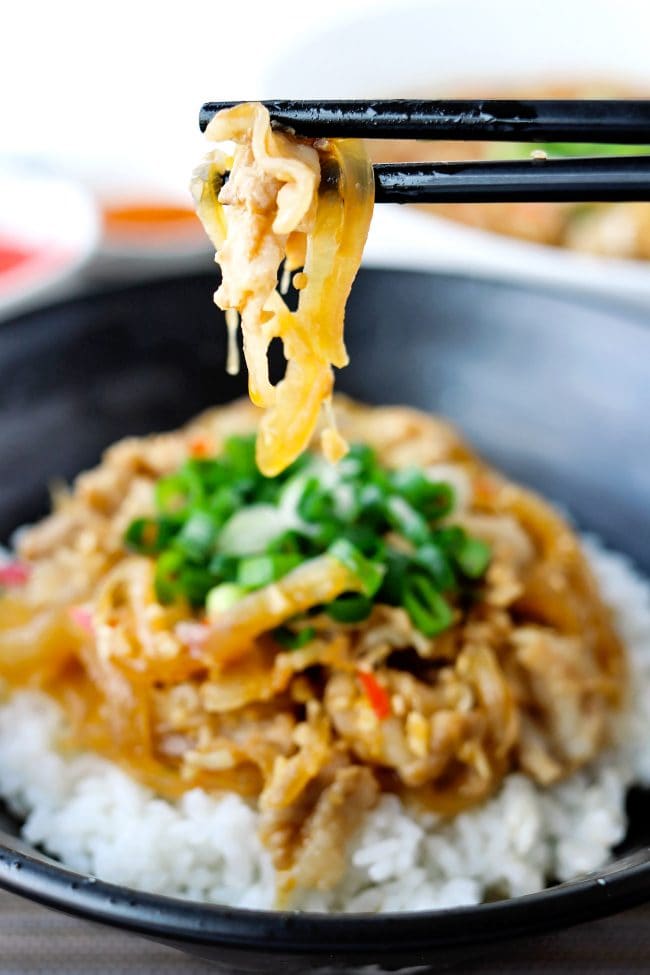
MORE EASY ASIAN WEEKNIGHT DINNERS
Looking for more easy weeknight dinner recipes? Below are some of my go-to favorites!
- Stir-fried Pork Sukiyaki in Black Pepper Sauce
- Spicy Kung Pao Chicken
- Chili Garlic Shrimp
- Three Cup Chicken (San Bei Ji)
- Braised Tofu & Mushrooms in Black Pepper Sauce (This one is both vegetarian and vegan)
- Or browse the entire Dinner recipe collection.

MADE THIS RECIPE? If you make this recipe, leave a comment below and let me know how you liked it! Take a photo and tag it with @thatspicychick on Instagram and hashtag it #thatspicychick and I’ll be sure to share your masterpiece!
PrintJapanese Pork Rice Bowl (Butadon)
This Japanese Pork Rice Bowl is quick and easy to make, packed with umami, and extremely comforting! Pork belly is simmered with onions and aromatics in a slightly sweet and mouthwatering sauce.
- Prep Time: 15
- Cook Time: 25
- Total Time: 40 minutes
- Yield: 5-6 1x
- Category: Dinner
- Method: Stovetop/Simmer
- Cuisine: Japanese
Ingredients
- 370 – 400g thinly sliced Pork Belly – cut into bite-sized strips
- 1.5 medium Yellow Onions – thinly sliced
- 10 Garlic cloves – minced
- 3-inch chunk of Ginger – grated
- 2 Spring Onion – chopped (for garnish)
- 10–18 Red Chilies (optional), to taste and deseeded depending on desired heat level – chopped
- 6 TBLS Low Sodium Light Soy Sauce
- 1.5 – 2 TBLS Mirin (Japanese sweet rice wine)
- 4 TBLS Sake (Japanese rice wine)
- 2 x 5g sachets Dashi Powder (Japanese fish stock powder)
- 700ml Water
- 2 TSP White Miso Paste
- 2 TSP Brown Sugar, more to taste
- 1.5 TSP Kosher Salt, to taste (use half the amount if using table salt)
- 1 TBLS Olive Oil
- 1.5 TSP Sesame Oil, plus ½ to 1 TSP more to drizzle on top of dish
- 1–2 TSP Chili Oil (optional), to taste
- 2 TSP Toasted White Sesame Seeds
- To Serve: Steamed white rice, pickled red ginger, shichimi togarashi (Japanese assorted red chili pepper)
Instructions
Prep:
- Prepare all the fresh ingredients: Chop the garlic, red chilies, and spring onion, and grate the ginger. Cut the thinly sliced pork belly into bite-sized strips.
- Make the sauce: In a measuring cup or medium sized bowl, combine the low sodium light soy sauce, mirin, and sake. Stir with a spoon until combined.
- Make the Dashi: Heat the water in a small stockpot or pot over medium-high heat. Once the water starts simmering, pour in the contents of the dashi powder sachets and stir to combine. Simmer for a minute, then switch off the heat and transfer the dashi to a measuring cup and set aside.
For the Japanese Pork Rice Bowl (Butadon):
- Heat olive oil, sesame oil, and chili oil in a large wok or stockpot over medium-high heat. Once hot, add the onion and sauté until softened – about 2-3 minutes.
- Add the garlic and ginger, and continue sautéing for 1-2 minutes until fragrant.
- Next, add the chilies and sauté for another minute to combine.
- Then add the pork and stir-fry until no longer pink and combine with everything else in the wok. – about 2-3 minutes.
- Pour in the dashi and sauce, and add the white miso paste, brown sugar, and kosher salt to taste. Stir to combine, then lower the heat to medium-low and cover the wok with its lid.
- Simmer for 12-15 minutes, stirring once or twice in between, then uncover the wok.
- Give everything a good stir, then switch off the heat and transfer to a serving dish.
- To Serve/Garnish: Sprinkle the toasted white sesame seeds and drizzle a little bit of sesame oil on top. Garnish with the chopped spring onion and serve over warm steamed rice, and with pickled red ginger and shichimi togarashi on the side if desired.
Notes
- To make this gluten free: Use Tamari or gluten-free soy sauce in place of the low sodium soy sauce. Also, double-check to ensure that the white miso, sake, and mirin you are using is GF certified.
Nutrition
- Serving Size: 1 serving
- Calories: 544
- Sugar: 5.3g
- Sodium: 1402.4mg
- Fat: 47.1g
- Saturated Fat: 15.7g
- Unsaturated Fat: 0g
- Trans Fat: 28.2g
- Carbohydrates: 14.1g
- Fiber: 2.3g
- Protein: 13.6g
- Cholesterol: 55.3mg
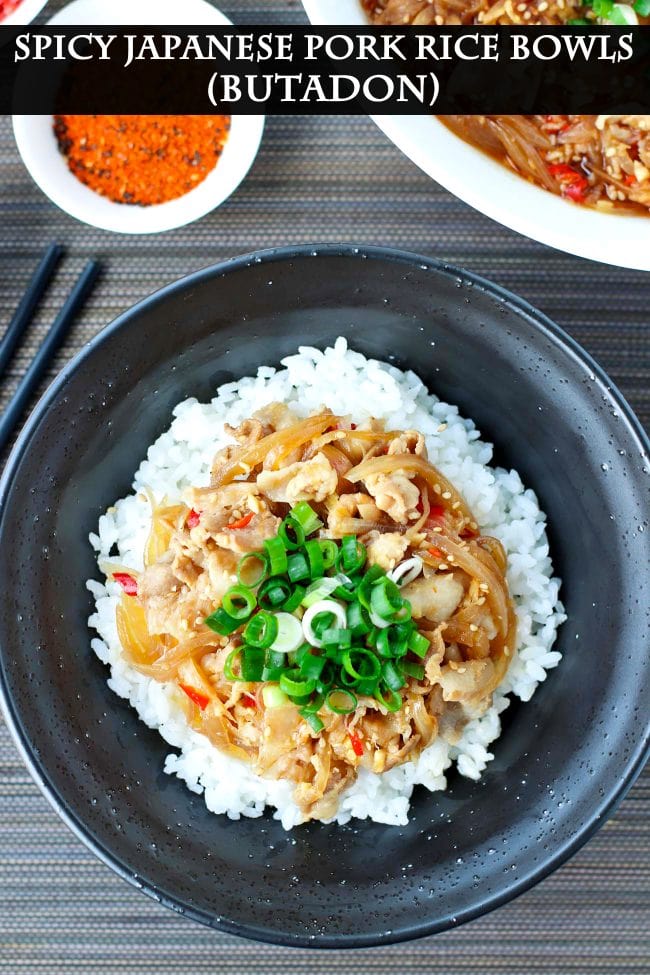
This post may contain affiliate links. We are a part of the Amazon Services LLC Associates Program, an affiliate advertising program designed to provide a means for us to earn a small commission (at no extra cost to you) by linking to Amazon.com and affiliated sites. The nutritional information provided is approximate and can vary based on several factors. It should only be used as a general guideline. For more information, please see our Disclosure.


